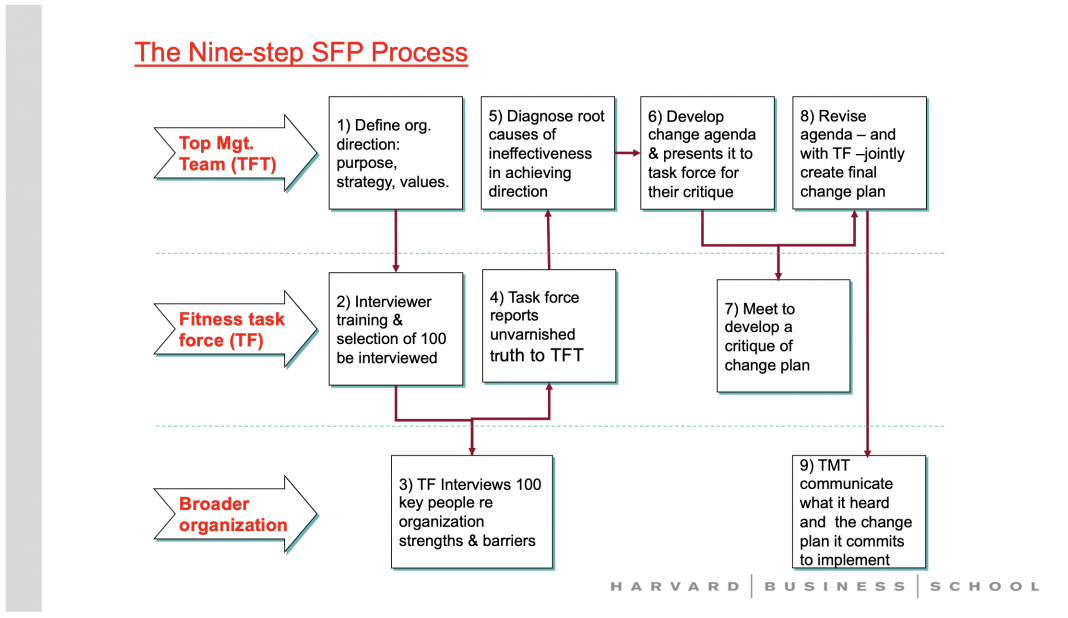Hewlett Packard’s Santa Rosa Systems Division was formed to take HP into a new and growing internet market. Yet, two years later, growth and profits were so disappointing that the senior team thought they were six months from being replaced. What saved them? An honest conversation about what was going wrong and overcoming organizational silence
Everyone in SRSD knew what the problems were, but no one could find a way to talk openly about it. Research – our own and others’ – finds that 80% of business, nonprofit, educational, governmental, and nongovernmental institutions fail to confront the truth about the flaws in their system of organizing, managing, and leading that keep them from carrying out their strategies. This phenomenon is called organizational silence. It undermines employee engagement, trust, and commitment and thus prevents senior management from learning about what is working and not working. Organizations beset with organizational silence are stuck in neutral, generally unable to learn what is holding them back and unable to change even what they do know about.
Organizational silence is pervasive because organizations are hierarchical, and people at the lower levels of a hierarchy – through a combination of courtesy and fear – avoid telling the people higher up how these leaders are failing. One executive, just below the top of a global pharmaceutical firm, put it plainly:
‘People don’t go to management with the options because they are afraid. They try to second-guess what management wants instead of what management really needs to know, and so problems build up.’
But it’s more than a matter of just ‘speaking up.’ Telling one executive what needs to be changed will not change the system – that is, the combination of factors that shape how the enterprise is organized, managed, and led. Only an organization’s senior team can lead and motivate systemic change – no one else has enough power.
The cost of organizational silence
The human and economic costs of organizational silence are enormous. Leaders and their people become passive when the system frustrates their efforts to achieve strategic goals. The organization becomes less innovative and less capable of collaborative and frictionless effort to implement its strategic tasks. Trust and commitment by all stakeholders – shareholders, employees, customers, suppliers, and others – declines. At the extreme, senior management is overtaken by disasters that those below them could see coming. Notorious examples include Boeing, Wells Fargo, Volkswagen, and Enron, but there have been many others.
What can be done to overcome organizational silence?
How to enable honest, collective, and internally public conversations
To enable leaders to overcome organizational silence, Dr Russ Eisenstat and I developed a structured nine-step strategic governance and learning process we call the Strategic Fitness Process (SFP). It is designed to enable top management teams to have an honest, collective, and internally public conversation with key lower-level leaders about organizational strengths to be preserved and about the barriers that stand in the way of the organization’s effectiveness and performance.
- By honest, I mean that the unvarnished truth about the organization is revealed and discussed.
- By collective, I mean that people representing all parts of the organization take part.
- By public, I mean that nothing is hidden from people in the organization. They are told what their leaders heard (the good, bad, and sometimes ugly) and then told— concretely—the leaders’ plans to change how the enterprise is organized, managed, and led.
SFP is depicted in the Figure below. It involves:
- The top management team (TMT).
- A task force commissioned by the TMT to learn the truth about barriers to effectiveness and report that to the TMT.
- The broader organization that provides the feedback reported by the task force.
What enables non-defensive, honest, and productive conversations
The nine-step process is designed to create a partnership between senior management and the whole organization by means of an honest conversation about what’s going right and what’s going wrong. To keep such a conversation from degenerating into recrimination or from getting off the track, it must adhere to the following principles:
- The conversation is focused on important issues that matter most: the strategic and cultural issues that motivate its participants.
- It iterates between advocacy and inquiry. The senior team advocates where it wants to take the organization and then, through the task force, inquires into the organization’s strengths and its barriers to success.
- The process is designed to make it safe to share the whole truth.
It must be disciplined and structured to prevent missteps such as defensiveness and blaming that would just shut the conversation down. - The process requires the TMT to reflect on the truth that has been presented to them, diagnose the root causes of problems, and develop an action plan for change that will realign the organization with the team’s espoused strategy and cultural values.
- The leadership team is accountable to those who provided the feedback—that is, to the whole organization—for having listened accurately to them and for planning effective responses.
- The process is repeated periodically. This makes continuous organizational learning and improvement possible.
SRSD’s top management team, for example, was stuck in neutral by their organization’s ineffectiveness in executing its strategy. Using SFP to have an honest conversation fundamentally changed how the business was organized and managed to better align with that direction. They also repeated SFP annually by linking it to the annual strategic planning process. Trust and commitment improved dramatically, and, as a result, so did the division’s business performance. Ned Barnholt, an HP executive VP, said:
‘Compared to other divisions, it’s probably the most dramatic improvement. Now, they are one of the top divisions in terms of growth, profitability, return on assets, and customer satisfaction.’
You can learn more about SRSD’s transformation and that of many other businesses in my book Fit to Compete: Why Honest Conversations about Your Company’s Capabilities Are the Key to a Winning Strategy. You can learn more about the book on my website and can order it on Amazon.


This work is licensed under Creative Commons Attribution-NonCommercial-NoDerivatives 4.0 International.


